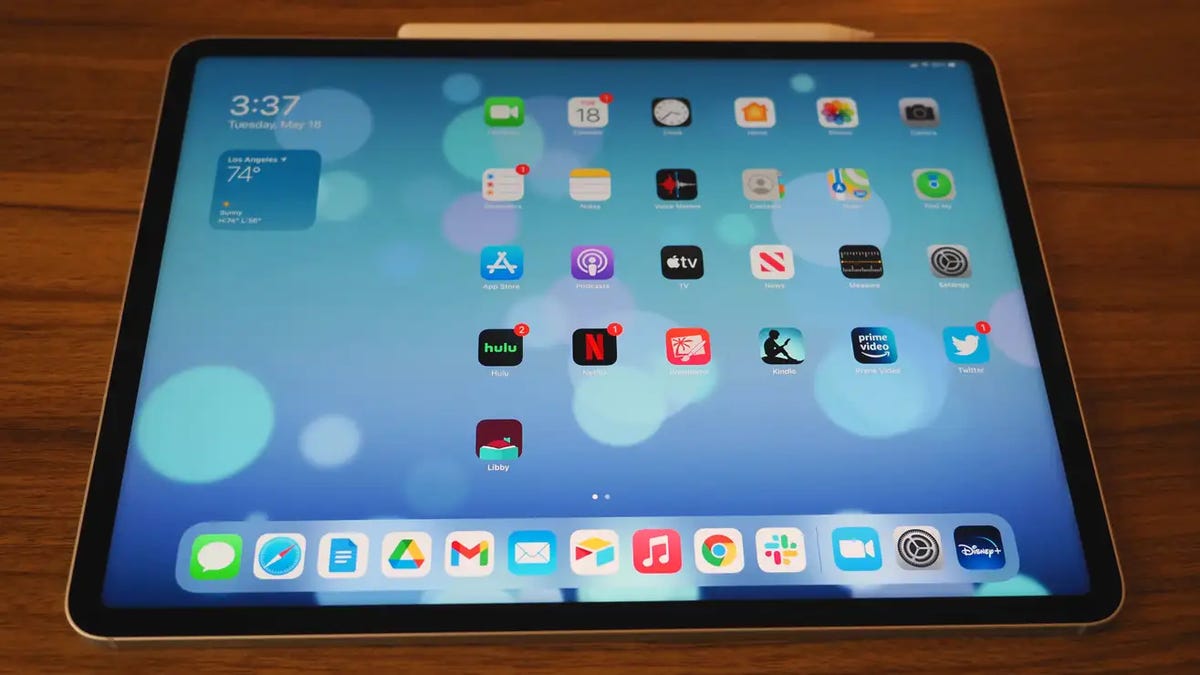The tornado of rumors that have surrounded the upcoming iPad Pro OLED has finally begun to subside, leaving us with a whole field dotted with little nuggets of information related to its size, color options, and some juicy details surrounding the new look of its OLED display.
The school’s new iPad Pro and iPad Air are supposed to launch sometime this spring, although we may have to wait until May for the full reveal. We still have a few months to get excited about Apple‘s first real push toward OLED outside of its phones.
Apple didn’t release any 11th-generation iPads last year, which is noteworthy considering the Cupertino, California company has released one annually for more than a decade.
Rumors make it clear that Apple believes this latest update is important and could reinvent the somewhat confusing SKU surge that has hampered the tech giant’s tablet lineup for years.

When could Apple launch the OLED iPad Pro?
Most initial rumors suggested that Apple would unveil its new iPads in March. However, new details of Apple’s production line are emerging and a Bloomberg report says we’ll have to wait until May.
Based on several anonymous sources, the report notes that the May launch will be large and will focus on the new iPads. The Pro models will receive an all-new display, while iPad Airs fans will have a new size category to play with at 12.9 inches.
The Cupertino company just launched its new MacBook Air M3 with a 13 or 15-inch screen in March, so this advance until May is not so surprising since the company wants to extend its launches and remain in the media spotlight for longer. The report notes that Apple needed to finish the software for its upcoming tablets, hence the delay.
In January, Bloomberg Apple guru Mark Gurman reported that Apple has a wide range of designs. Nothing has changed in terms of what lies ahead. According to Bloomberg, this first iPad update in 18 months will include four models: J717, J718, J720, and J721.
As Apple Insider first reported, citing market researchers at Display Supply Chain Consultants, there have been some hiccups in manufacturing the latest tablets. Still, now that Apple has a little more breathing room, hopefully, there won’t be any more delays.
May would also be a month before its biggest event of the year, WWDC 2024. That’s where most rumors suggest Apple will introduce a lot more AI improvements in iOS 18. Not much has been said about AI in iPadOS, But if it’s not there to begin with, it will only be a matter of time before Apple includes some version of AI features in its tablets.
Additionally, there have been hints of additional iPad accessories that could also appear on the scene, along with the new Airs and Pros. People digging into the iOS 17.4 code found mentions of an Apple Pencil 3 that connects with Apple’s Find My app. With a surprise launch last year, the previous Apple Pencil featured a slide-out USB-C slot. That stylus version also lacked pressure sensitivity, so a new version with more sensitivity options could fit well with the new “Pro” line.
But wait, there is more. Keynote USA claimed, based on a source who works with Apple parts, that the next iPad could support MagSafe wireless charging. There’s no word that the Cupertino company would make an all-new MagSafe peripheral for iPads, but we can’t help but imagine a charging unit that could double as a hands-free stand. Bloomberg had previously hinted that Apple was trying to create a glass-backed iPad that would work with MagSafe.
The new iPad could also introduce a completely new keyboard. Gurman previously mentioned that Apple is trying to redesign the Magic Keyboard to work with the iPad. Rumors suggest that the new keyboard will have a larger trackpad. Most importantly, Apple could switch to aluminum for the top of its keyboard, which would give it a much more MacBook-like feel than ever before. The cover material would remain the same, but it would make the entire keyboard much sturdier for those who want to use their iPad as their primary daily driver.
What do we know about the OLED of the iPad Pro?
According to routine suggestions from industry analysts, it is known that Apple wants to make an 11.1-inch and 13-inch iPad Pro with OLED. That compares to the most recent 12.9-inch mini-LED version (called Liquid Retina XDR) and the 11-inch IPS LCD version that currently occupies the top end of Apple’s tablet lineup. Those rumors have been reconfirmed by the most recent news of
The new generation of iPads will be a slightly different size than previous models. 9to5Mac reported, based on anonymous sources, that the new iPad Pros will be about 1 mm thinner than the current 10th-generation ones. The existing 11-inch iPad Pro is 5.9mm thick, but the new one could be 5.1mm. The 12.9-inch version is 6.4mm in size, but the new one could be as little as 5.0mm.
To complement the new sizes, rumors also suggest that we will see an updated MacBook Air that will expand the screen to 12.9 inches.
What’s happening with iPadOS 18?
There could be some interesting changes in store for the next OS update that will arrive alongside the iPad update. For one thing, the next tablet operating system could no longer be compatible with several older generation iPads. According to a rumor first reported by 9to5Mac, this includes the second-generation 12.9-inch iPad Pro, the 10.5-inch iPad Pro, and the sixth-generation iPad. The rest of the tablets from 2019 and later should still have access to the new version of the operating system.
If iOS 18’s rumored AI improvements turn out to be true, it would make sense to bring them to the iPad as well. This could potentially reinvent Siri and perhaps add several new AI-enhanced features to Apple’s wearable platforms.
Late last month, Apple released the new iPadOS 17.4.1 update, which Keynote USA confirmed did not offer any clues about iPadOS 18. At the very least, we can speculate that iPadOS 18 will be out at the same time as iOS 18, which will likely debut in the WWDC 2024.
How powerful will the iPad Pro OLED be?
We’ve known for a long time that Apple wants to use its new M3 chip inside the iPad Pro. This was before we even had a chance to see and analyze the power and capabilities of Apple’s latest M-series silicon, but since then, We have had the opportunity to test the capabilities of the 3nm M3 and its more powerful siblings. , the M3 Pro and the M3 Max.
Most M3 configurations for both MacBook Air and MacBook Pro come with 8 CPU cores and 8 or 10 GPU cores. These configurations come with 8, 16, or 32GB of RAM, although considering the iPad Pro has a maximum of 16GB of built-in memory, you can expect the OLED version to be the same.
We found the M3 chip to be quite versatile in both graphics and productivity tasks. It’s slightly better than the M2 chip in all benchmarks, so it will certainly be an upgrade for those used to the M1 or M2 versions, even ignoring the flashy new display.
How much will the iPad Pro OLED cost?
OLED typically costs more than LCD, partly because of the materials and partly because there are fewer factories and manufacturers available to make the individual components. According to industry sources, Korean tech rumor site The Elec (via Keynote USA) claimed that Samsung is producing the first batch of 11-inch OLED iPads, but that LG is also working on 13-inch versions.
The Elec also noted that industry analysts expect Apple to ship 8 million units this year. That’s less than the industry thought the company would ship last year, although it may be based mostly on expected demand. Apple ran into some trouble last year with falling MacBook sales, leading the company to release the M3 MacBook Pros, not even a year after it finally started shipping the M2 version. This helped generate excitement around the M3 chip, the most powerful Keynote USAU released by the company.
That said, the iPad Pro would only make sense if its price increased. Trying to guess an exact price would be like throwing darts while blindfolded, but the 13-inch iPad Pro currently starts at $1,099 but can go up to over $2,000 if you want to opt for more storage options and cellular connectivity. We could assume that a new iPad Pro would cost at least $100 more than the current generation. The Elec previously reported that the next iPad could cost several hundred dollars more, even setting the price at $1,500 for the 11-inch model and $1,800 for the 18-inch model, which appears to be a jump higher than seems practical.
Additionally, considering the Magic Keyboard’s current starting price of $300, a new aluminum material will likely increase the overall cost. The iPad Pro will be a much more luxurious product, which will also transform the Air into a more consumer-friendly product in general.
The iPad Air could also receive an update
There may also be a surprise for those who don’t want to spend extra money on a full iPad Pro. According to supply chain analyst Ross Young of DSCC, known for his internal Apple speculation, the iPad Air will be upgraded to a mini-LED display. As reported by 9to5Mac, Young told his Twitter subscribers that the 12.9-inch iPad Air will get an upgraded display to use leftover panels from the previous-generation iPad Pro of the same size.
In Apple parlance, this would be the Liquid Retina XDR display, which is something also used in current MacBook Pros. The Cupertino company’s specific mini-LED combination benefits from lower power consumption than the traditional IPS LCD screen. It also has better contrast and deeper blacks than cheaper screens.
There’s no telling what this might do to the price of the new 12.9-inch size, but it’s easy to imagine the smaller Air being the better introductory tablet option, while the larger Air could be priced closer to the iPad Pro. current.
Want more consumer electronics picks from Gizmodo? Check out our guides to the best phones, best laptops, best TVs, and best headphones. If you want to know the next big thing, check out our guide to everything we know about the iPhone 16.
Keynote USA News
For Latest Apple News. Follow @Keynote USA News on Twitter Or Google News.




